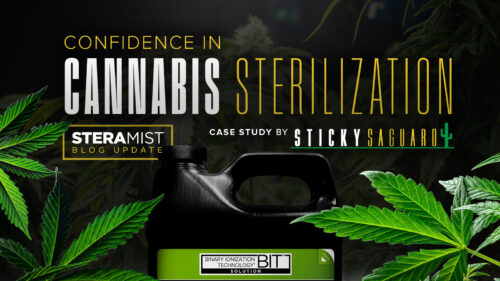NAVIGATING THE FOG WITH IONIZED HYDROGEN PEROXIDE
The History of Hydrogen Peroxide as a Disinfectant
The discovery of hydrogen peroxide in 1818 by Louis Jacques Thénard [1] marked a pivotal moment, as its composition revealed an extra oxygen atom compared to water. Through decomposition, this additional reactive oxygen atom separates to release energy and produce both water and oxygen molecules. This unique chemical property grants hydrogen peroxide powerful oxidizing abilities, rendering it an effective disinfectant. Its capability to eradicate microorganisms stems from its reactive nature, which breaks down cellular structures, disrupts crucial functions, induces DNA damage, and eliminates infectious agents.
Techniques of Hydrogen Peroxide Disinfection: VHP, HPV, HHP, iHP
There are several techniques in which hydrogen peroxide is used as a disinfection method, all featuring acronyms with some variation of “HP”, or Hydrogen Peroxide. Traditionally over the last 40-50 years, a method involving the use of high concentrations of hydrogen peroxide has been utilized. This approach involves applying a high concentration for a specific duration on surfaces to achieve significant microbial reduction. This method is commonly referred to as vaporized hydrogen peroxide or hydrogen peroxide vapor. Various companies promote the use of 35% hydrogen peroxide in conjunction with a vaporizer to support their disinfection claims.
Alternatively, some companies opt for a lower concentration of hydrogen peroxide, incorporating an additive, such as silver, to enhance microbial reduction. However, the additives in this approach can lead to equipment corrosion and pose environmental risks. One of the newest strategies in the industry employs a ‘pulsing’ technique, spreading a low concentration of hydrogen peroxide throughout an area and sustaining a fog by intermittently adding more hydrogen peroxide for at least 30 minutes. Despite the claim of using only 7% hydrogen peroxide, the extended duration required for pulsing and the maintained concentration of hydrogen peroxide in the area may also lead to corrosion issues and a lengthy turnaround time.
An innovative approach, ionized hydrogen peroxide (iHP), eliminates the concern associated with high concentrations of hydrogen peroxide, the use of additives, and the extended time required when pulsing. Using a low-concentration 7.8% hydrogen peroxide solution, hydroxyl radicals are formed when passed through a cold plasma arc to create iHP and maintain the integrity of surfaces, facilities, and sensitive equipment, avoiding the need to compromise on critical disinfection.
Looking into the Label
Beyond the chemical composition and the techniques required to achieve high-level decontamination, it is crucial to carefully review Safety Data Sheets (SDS) for information on potential safety hazards, the composition and details of ingredients, as well as guidelines for safe handling and storage. While the specific inert ingredients may not be disclosed to the public, examining the safety data sheet for information like flashpoint testing can help assess the chemical’s hazardous properties.
In addition to reviewing Safety Data Sheets, it’s also important to look at the EPA label, registrations, and third-party studies. SteraMist iHP stands out as the only combination of both a hydrogen peroxide-based system and equipment to be registered with the EPA. This indicates that its EPA registration was achieved through testing that involved passing hydrogen peroxide through a cold plasma arc, marking the first instance of such a procedure and ensuring repeatable results when compared to less consistent methods of application.
Obtaining registrations and conducting studies to support the efficacy claims of a disinfectant involves a comprehensive process and extensive transparency. It’s beneficial to explore the studies and registrations associated with a company’s technology to make an informed decision that meets your specific requirements. Check out SteraMist iHP technology studies and case studies here.
[1] Janoff LE. Origin and development of hydrogen peroxide disinfection systems. CLAO J. 1990 Jan-Mar;16(1 Suppl):S36-42. PMID: 2407383.



